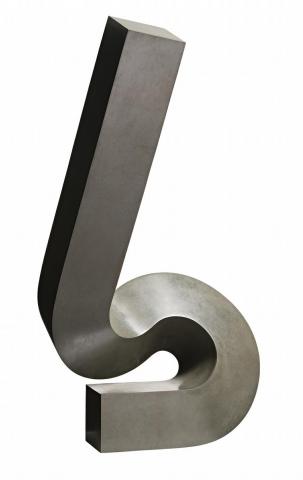START UP, 1999
Clement Meadmore
bronze
92.0 cm height
signed, dated and inscribed at base: Meadmore 1999 A.P. 1
Sculpturesite Gallery, San Francisco
Private collection, Perth
Upstart I, 1967, steel, 625.0 cm, Milwaukee Art Centre, United States of America, and Upstart II, 1968, steel, 777.0 cm, Corcoran Gallery of Art, Washington D.C., in Gibson, E., The Sculpture of Clement Meadmore, Hudson Hills Press, New York, 1994, pp. 48, 49, 52 (illus.)
Unmistakably reminiscent of the large public sculpture Upstart II, 1968, in the collection of the Corcoran Gallery of Art, Washington D.C., indeed Start Up 1999 is closely related to an earlier series of works by Meadmore - including the acclaimed Upstart I, 196, Swing, 1969, Verge, 1970, and Double Up, 1970, - in which he crosses a threshold, infusing his art for the first time with many of the qualities that would come to distinguish it from his own and other sculpture of its time, not only in form and character, but in quality.
To begin with, these sculptures of the late 1960s and early 1970s are less closed, less inward-turning than their predecessors. Instead, they open up more and begin to reach beyond themselves, sometimes with startling aggressiveness and daring... They also highlight the risks of having a sculpture be little more than an open line in space, a risk that Meadmore deliberately and successfully pushes as far as he can in these particular works. Meadmore's most open and attenuated sculptures, they are among his most succinct and elegant. Taken together, they highlight, as almost no other work, the opposition between line and mass that lies at the core of Meadmore's sculpture. In addition, they represent the ultimate expression, in their expansiveness and dispersal, of the lesson he had learned from Barnett Newman.
By opening up more now, by adopting more irregular configurations, and particularly by abandoning their tense coilings, Meadmore's sculptures change noticeably. They can no longer be read in terms of a beginning, a middle and an end. Instead, they become more episodic, one moment appearing self-contained and at another simply appearing as one segment of an absent whole. In so doing, they become more abstract.
'...The cumulative effect of these changes is that Meadmore's sculptures have become more gestural. That is, in their form they suggest the rapid motion through space of a limb or a body, or the disembodied residue of such motion. They have more in common with purely aesthetic things, such as a drawn line, than with a recognizable object existing in the world...'1
1. Gibson, E., The Sculpture of Clement Meadmore, Hudson Hills Press, New York, 1994, pp. 47 & 52.
VERONICA ANGELATOS
